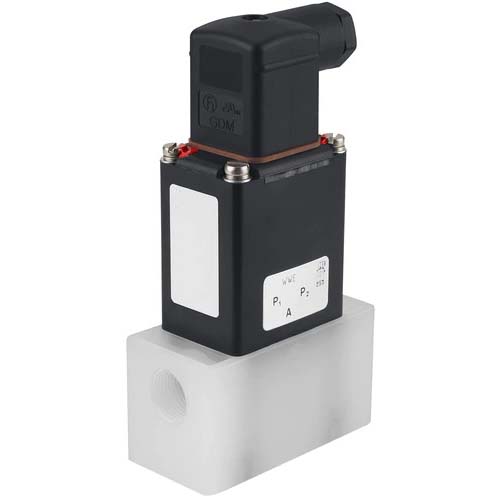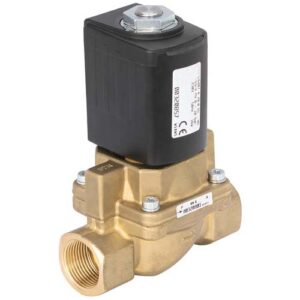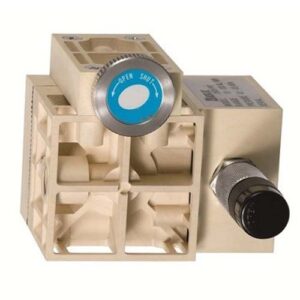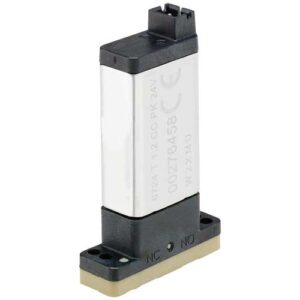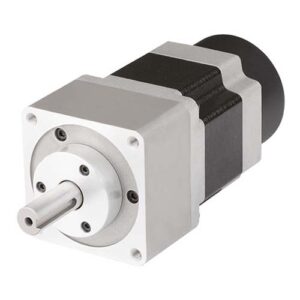FGT think your best choice in the future
System Integration Designers in FGT
Direct Acting 2/2 or 3/2 Way Pivoting Solenoid Valve Model 0121 Series
The 0121 valve is a direct-acting, media-separating pivot-type armature valve. It is available as 2/2 and 3/2 way variants. As a 3/2-way variant, it can be used as a distributor or mixing valve. Various diaphragm materials and circuit functions are available according to the actual application. Body range includes stainless steel (316L), PTFE and PVC versions. The solenoid coil is molded in chemically resistant epoxy. Since the coil system is separated from the medium by a diaphragm, the valve is especially suitable for critical media such as corrosive acids and lyes. The 0121 is equipped with manual override for start-up and testing. To reduce energy requirements, all coils are available with reduced electronic power or as a pulsed variant. Switch status can be indicated as binary or NAMUR signal via position feedback
The 0121 valve is a direct-acting, media-separating pivot-type armature valve. It is available as 2/2 and 3/2 way variants. As a 3/2-way variant, it can be used as a distributor or mixing valve. Various diaphragm materials and circuit functions are available according to the actual application. Body range includes stainless steel (316L), PTFE and PVC versions. The solenoid coil is molded in chemically resistant epoxy. Since the coil system is separated from the medium by a diaphragm, the valve is especially suitable for critical media such as corrosive acids and lyes. The 0121 is equipped with manual override for start-up and testing. To reduce energy requirements, all coils are available with reduced electronic power or as a pulsed variant. Switch status can be indicated as binary or NAMUR signal via position feedback
-
- Direct-acting media separation valve up to DN 8
- Maintenance-free pivoting armature technology
- Anti-vibration, block threaded coil system
- Service friendly, powerful manual operation
- Explosion-proof
Solenoid valve use | Our performance
Needle valve use | Our performance
Flow Control Valve Purpose | Our performance
Two-way valve use | Our performance
Solenoid valve introduction
The working principle of the solenoid valve, the solenoid valve has a closed cavity, and there are through holes in different positions. Each hole leads to a different oil pipe. When the valve body is energized, it will be attracted to which side. By controlling the movement of the valve body, it blocks or leaks different oil discharge holes, and the oil inlet hole is normally open, and the hydraulic oil will enter different oil discharge pipes, and then pass through The pressure of the oil pushes the piston of the oil, the piston drives the piston rod, and the piston rod drives the mechanical device to move. In this way, the mechanical movement is controlled by controlling the current of the electromagnet.
Classification:
Solenoid valves at home and abroad are divided into three categories in principle (ie: direct-acting, step-by-step direct-acting, pilot-operated), and they are divided into six branches from the difference in valve structure and material and the difference in principle Small category (direct-acting diaphragm structure, step-by-step heavy-plate structure, pilot diaphragm structure, direct-acting piston structure, step-by-step direct-acting piston structure, pilot piston structure), according to the number of air paths, it is divided into 2-position 2-way, 2-position 3 Pass, 2-position 4-pass, 2-position 5-pass.
Solenoid valve is divided into single electric control and double electric control, which refers to the number of solenoid coils, single coil is called single electric control, double coil is called double electric control, 2-position 2-way, 2-position 3-way general When it is single electric control (single coil), 2-position 4-way, 2-position 5-way can be single electric control (single coil) or double electric control (double coil).
1. Solenoid valves can be divided into: liquid solenoid valve, gas solenoid valve, steam solenoid valve, gas solenoid valve, oil solenoid valve, special solenoid valve for fire fighting Valve, refrigeration solenoid valve, anti-corrosion solenoid valve, high temperature solenoid valve, high pressure solenoid valve, non-pressure solenoid valve, ultra-low temperature solenoid valve (cryogenic solenoid valve), vacuum solenoid valve, etc.
2. According to the internal structure of the solenoid valve, it can be divided into pilot type, direct-acting type, compound type, recoil type, self-maintaining type, pulse type, bistable, bidirectional type, etc.
3. According to the different materials of the solenoid valve, it can be divided into: cast iron body (gray cast iron, ductile iron), copper body (cast copper, forged copper), cast steel body, all stainless steel body (304, 316), non-metallic materials (ABS, Teflon).
4. According to the pressure of the medium in the pipeline, it can be divided into: vacuum type (-0.1~0Mpa), low pressure type (0~0.8Mpa), medium pressure type (1.0~2.5Mpa), high pressure type (4.0~6.4Mpa), Ultra-high pressure type (10~21Mpa)
5. According to the temperature of the medium, it can be divided into: normal temperature type (~), medium temperature type (~), high temperature type (~), ultra-high temperature type (~), low temperature type (~), ultra-low temperature type ().
6. According to different working voltages, it is divided into: AC voltage: AC220V 380V 110V 24V; DC voltage: DC24V 12V 6V 220V; general common voltage is AC220V DC24V, it is recommended that users try to use common voltage and special voltage with a longer supply cycle.
7. According to the protection level of the solenoid valve, it can be divided into: explosion-proof type, waterproof type, outdoor type, etc.
In principle:
Direct acting solenoid valve:
Principle: When energized, the electromagnetic coil generates electromagnetic force to lift the closing member from the valve seat, and the valve opens; when the power is off, the electromagnetic force disappears, the spring presses the closing member on the valve seat, and the valve closes.
Features: It can work normally in vacuum, negative pressure and zero pressure, but the diameter generally does not exceed 25mm.



Distributed direct acting solenoid valve:
Principle: It is a combination of direct action and pilot type. When there is no pressure difference between the inlet and the outlet, after the power is turned on, the electromagnetic force directly lifts the pilot valve and the main valve closing member upwards in turn, and the valve opens. When the inlet and outlet reach the starting pressure difference, after the power is turned on, the electromagnetic force pilots the small valve, the pressure in the lower chamber of the main valve rises, and the pressure in the upper chamber drops, so that the main valve is pushed up by the pressure difference; when the power is off, the pilot valve uses a spring The force or medium pressure pushes the closing member, moving downward, causing the valve to close.
Features: It can also act safely under zero pressure difference or vacuum and high pressure, but the power is large and must be installed horizontally.
Pilot operated solenoid valve:
Principle: When the power is turned on, the electromagnetic force opens the pilot hole, the pressure in the upper chamber drops rapidly, and a pressure difference between upper and lower parts is formed around the closing member. The fluid pressure pushes the closing member to move upward and the valve opens; When the hole is closed, the inlet pressure passes through the bypass hole to quickly form a pressure difference between the lower and upper parts around the valve closing member, and the fluid pressure pushes the closing member to move down to close the valve.


Solenoid valve inIn the liquid circuit system, it is used to realize the on-off of the liquid circuit or the change of the direction of the liquid flow, it generally has a valve core that can slide under the electromagnetic force of the coil. When the valve core is in different positions, the path of the solenoid valve is also different. There are several working positions of the valve core, and the solenoid valve is called several solenoid valves: the interface on the valve body, that is, the number of passages of the solenoid valve, there are several passage ports, and the solenoid valve is called several solenoid valves.
According to the number of air paths:
The "X position" of the "X position Y pass" solenoid valve represents that the valve has several states:
"2-bit" means two states of "on" and "off" - P→A, P→B, A→R, B→S, etc., the disconnected gas path is in the exhaust state;
"3-bit" includes the above two states, and also includes the third state - for the first exhaust/no exhaust, and for the second exhaust/no exhaust, there are various combinations.
"Y-pass" refers to the number of holes in the solenoid valve. For the gas solenoid valve, due to the problem of exhaust, there may be 2 holes (1 inlet, 1 outlet), 3 holes (1 inlet air, 1 outlet, 1 exhaust), 4 holes (1 inlet, 2 outlet, 1 exhaust), 5 holes (1 inlet, 2 outlet, 2 exhaust); For liquid solenoid valves, there is no venting problem, since liquids generally cannot be vented.
P——POWER, air inlet;
A - air outlet 1 (connected to the cylinder);
R——the exhaust hole that communicates with the air outlet 1 (the B-side coil has been controlled by electricity or manually, and the two holes are connected when the A-side coil is not energized);
B - air outlet 2 (connected to the cylinder);
S—the exhaust hole that communicates with the air outlet 2 (the coil on the A side has been controlled by electricity or manually, and the two holes are connected when the coil on the B side is not energized);
Two-position two-way (1 inlet, 1 outlet)
When the power is off, the pressure port is connected to the cylinder port - when the power is turned on, the pressure port and the cylinder port are closed;
Two (three) tee (1 inlet, 1 outlet, 1 exhaust)
Normally open: When the power is off, the pressure port is connected to the cylinder port and the exhaust port is closed - when the power is turned on, the pressure port is closed and the cylinder port is connected to the exhaust port;
Normally closed: when the power is off, the pressure port is closed and the cylinder port is connected to the exhaust port - when the power is turned on, the pressure port is connected to the cylinder port and the exhaust port is closed;
Typical configuration: Allows the valve to be connected in either normally closed or normally open positions, or to select one of the two fluids, or to switch flow from one port to the other

Two-position four-way (1 inlet, 2 outlet, 1 exhaust)
Generally used to operate double-acting cylinders, in one position, the pressure port is connected to the A cylinder port, and the other B cylinder port is connected to the exhaust port, in the second position, the pressure port is connected to the B cylinder port, and the other A cylinder port is connected connected to the exhaust port;


